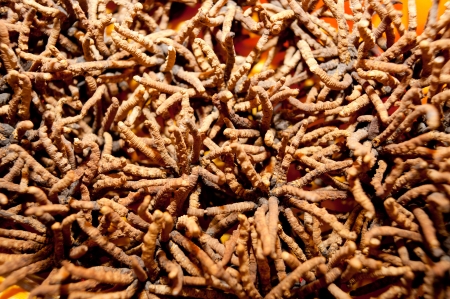Cordyceps - Caterpillar Fungus

Common Names: Cordyceps, Caterpillar Fungus, Vegetable Caterpillar, CS-4, Tochukaso, Dong Chong Xia Cao, Hsia Ts'Ao Tung Ch'Ung, Dong Chong Zia Cao, Campignon Chenille, Ophiocordyceps sinensis, Cordyceps sinensis
Latin Name: Cordyceps sinensis (Ophiocordyceps sinensis)
Origin: Asia
Short Introduction
Cordyceps can be cultivated in laboratory conditions or greenhouses virtually anywhere, regardless of altitude or climate. However, the highest quality Cordyceps is wild-harvested from the high plateaus of Tibet and China, where the mushrooms are richest in biologically active compounds.
Detailed Description
Cordyceps can help you exceed your limits—whether in sports or in the bedroom!
Botanical Information
The genus Cordyceps belongs to the family Ophiocordycipitaceae and comprises parasitic fungi that infect insects and other arthropods—primarily growing on the larvae of butterflies and moths, especially those of the Thitarodes genus. Another notable host for Cordyceps sinensis is T. armoricanus, which inhabits the underground regions of the Tibetan plateau. The fungus releases spores that travel by wind and settle on soil and plants. Once spores come into contact with suitable insect hosts, they invade the larvae, which burrow into the earth and feed on plant roots. The fungus slowly colonizes the insect’s body, eventually killing and replacing its tissue—a process that may take up to six years. The mature fungus produces a cylindrical fruiting body 5–10 cm long with a golden-brown hue, emerging from late spring to early summer. The stroma, or fungal tissue body, bears many smaller fruiting structures containing spores. When dried, Cordyceps typically ranges from 3 to 10 cm in length.
Origin and Distribution
Cordyceps sinensis naturally originates from the Tibetan plateau at altitudes of around 4,000 meters above sea level. The finest specimens are found at elevations from 3,800 to 6,000 meters, primarily in Tibet but also in the Chinese provinces of Sichuan, Gansu, Qinghai, and Yunnan, as well as certain regions of Nepal, Bhutan, and the Indian Himalayas. Due to historically high demand, the price for just one natural specimen (about 0.5 g) could reach $100 USD, and 1 kilogram could fetch approximately 500,000 CZK. Such demand led researchers to culture strains through DNA isolation and sequencing; this gave rise to the mycelial strain known as Paecilomyces hepialy, available under the name CS-4 since 2005.
Usage / Dosage
Cordyceps has long been used in traditional Chinese medicine as a potent remedy, and wild collection remains a crucial source of income in some parts of Tibet and China. While Cordyceps has been recognized for centuries globally, it is especially esteemed in Tibetan medicine, where it features as a foundational ingredient of the local 'materia medica' with documentation dating as far back as the 15th century in the writings of notable healers such as Zurkhar Namnyi Dorje.
Legend speaks of Tibetan herders noticing that livestock grazing on Cordyceps exhibited remarkable strength, vitality, and fertility, prompting them to collect the fungus for medicinal uses. Cordyceps thus became a cornerstone in treating respiratory, kidney, and cardiovascular disorders, boosting libido, promoting wound healing, and even soothing hiccups.
Today, Cordyceps is increasingly popular in self-care for enhancing athletic performance and accelerating recovery. When taken with other functional mushrooms like Reishi or Lion’s Mane, it may increase stress resilience, lift mood, support heart and lung health; alone it supports kidney function, immune health, and regulates sexual dysfunction. Animal and clinical trials suggest that Cordyceps’ active compounds boost energy, stamina, and endurance, enhance oxygen utilization, and help combat fatigue by moderating the effect of oxidative stress and free radical accumulation. Its polysaccharides, glycoproteins, peptides, and ergosterol possess significant antioxidant activity, potentially reducing inflammation and pain throughout the body.
Cordyceps’ components may slow aging. Other research highlights its role in regulating blood sugar, protecting pancreatic tissue, and enhancing insulin sensitivity. In animal models, consumption led to increased insulin production and greater tissue sensitivity to insulin—a smaller insulin amount achieved better blood glucose control.
Cordyceps has also demonstrated a notable antihyperlipidemic effect: its components reduced fat accumulation and inhibited pancreatic lipase activity, thus decreasing fat absorption. Such effects can lower cholesterol and triglycerides and reduce risk of atherosclerosis.
Several studies report Cordyceps’ kidney-protective benefits—it has shown positive effects for chronic nephritis, pyelonephritis, nephritic syndrome, and renal failure, apparently preventing cell death and damage in kidney tissue.
Research also indicates that cordysobin—a protease in Cordyceps—acts as a reverse transcriptase inhibitor, reducing viral infections in vitro. Other bioactive compounds show potential against HIV and hepatitis B or C, and Cordyceps has shown antibacterial activity in animal studies.
Beta-glucans and related compounds found in Cordyceps modulate immune system activity, supporting the body’s defenses against infection by enhancing the function of macrophages, natural killer (NK) cells, dendritic cells, and other innate immunity actors.
In traditional Chinese medicine, Cordyceps is lauded as a tonic and aphrodisiac with a warming nature and sweet flavor, especially nourishing to the lungs and kidneys. It is said to 'strengthen yang and ming,' support 'qi,' benefit lung yin, resolve phlegm, stop cough, and calm the spirit.
Active Compounds
Cordyceps sinensis contains numerous unique components: polysaccharides and derivatives (20–30%), glycoproteins, peptides, and most notably, nucleosides (e.g., deoxyadenosine, cordycepin, and derivatives of adenine, adenosine, inosine, cytidine, cytosine, guanine, uridine, thymidine, uracil, hypoxanthine, and guanosine), with identified anticancer and antiviral potential. The fungus also includes sterols (ergosterol and derivatives), proteins (such as DNAse, serine protease), amino acids (e.g., tryptophan, glutamic acid), various polypeptides, and a variety of vitamins and minerals, all contributing to its broad spectrum of beneficial effects.
Traditional Dosage
The recommended daily dose of Cordyceps depends on the form (extract, capsule, tablet) and the health condition being addressed. Typical daily intake ranges from 1 to 6 capsules. It is generally suggested to take Cordyceps regularly for 5 days, then take a 2-day break, and in a preventive regimen, to use 1–2 doses daily for several months. For optimal absorption, Cordyceps is best taken on an empty stomach, ideally 30 minutes before meals.

